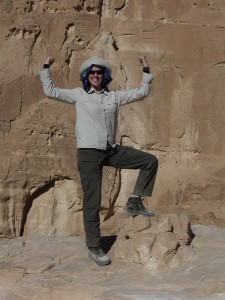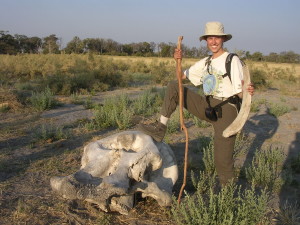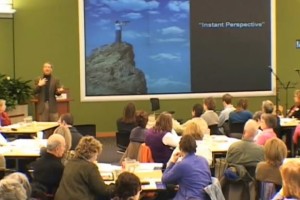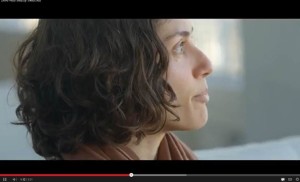Note from David: This magical story is a wonderful example of what I call an “I didn’t think I could do it…but I did” story. Technically, it’s more of a cousin to this genre…it’s more of a “I didn’t think I would survive it…but I did!” story.
These stories are powerful vehicles for helping people facing major life challenges to remember that they are stronger than they think.
This simple reminder is one of the perspective shift techniques I encourage people to use in the programs I do on resilience training.
More specifically, I recommend that when you are going through hard times, to remember really tough storms you have already weathered and remind yourself:
“Hey…if I could handle THAT…I can handle THIS!”
While your “THAT” might not be as wild as Martina’s, I’m sure you have some experiences that, when recalled, can easily remind you of how resilient and resourceful you have proven yourself to be in the past.
You Can Use This Type of Story When Coaching Some Who Is Feeling Overwhelmed
You can use your own “I didn’t think I could do it…but I did!” story to help others you coach shift into a more resourceful, empowered state of mind while facing challenges.
Here’s the very simple process:
1. Share the concept of “You are stronger than you think” with them and how when we are facing challenges, its easy to feel small and overwhelmed. While in that state, we cannot see options and opportunities.
2. Ask them to list major challenges they’ve overcome in their life and to tell you about at least one of them. As they recount their story of overcoming, they start to shift them into a more resourceful, empowered state. Once in that more empowered emotional and mental state, they can see opportunities and options where before they could only see obstacles.
3. If they are too overwhelmed or distraught to come up with any examples–share an example from your own life–i.e. your version of Martina’s–and see if that helps them connect with an experience of theirs that revealed to them their true measure of courage and strength.
4. After they tell their story or stories, they will have shifted into a more reourceful state. Once in that state, they are far more able to look at their current challenge with a “Can do” spirit and see options and opportunities previously unnoticed.
OK…enough of how to use this type of story..let’s get to Martina’s magical story…
What’s Your Africa?
by Martina Mangelsdorf
 When it comes to facing challenges and overcoming obstacles, it helps to have a mantra that you can call upon when you need encouragement, comfort and self-motivation. Mine is Africa.
When it comes to facing challenges and overcoming obstacles, it helps to have a mantra that you can call upon when you need encouragement, comfort and self-motivation. Mine is Africa.
I was fortunate to see a lot of planet Earth when, in my late 20’s, I fulfilled my childhood dream of backpacking around the world solo. In total, I spent 15 months on the road, travelling across five continents on a shoestring. This life changing experience not only shaped my view of human nature, it also provided me with an infinite number of lessons learned that I will be able to call upon for the rest if my life.
This one is about how getting the right advice at the right time can shape your destiny and how a moment of crisis and break-down can serve as a source of inspiration and strength later on.
I started my world trip crossing the African continent from Cairo to Cape Town, travelling almost the entire distance overland. A couple of months into my trip, I was about to leave Lusaka, the capital of Zambia, and planned to take a public transit bus to Lilongwe, Malawi. I arrived at the bus station a quarter past nine in the morning and bought my ticket for this 12-hour ride. The bus wasn’t there yet but the guy at the ticket counter assured me that it was about to arrive “just now”. Interpreting that as “in a little while from now” I took off my backpack and looked for a place to sit. There was only one small bench which was already taken by other waiting passengers. It was pretty cold – and when I say ‘pretty’, I mean I was freezing – but I thought, whatever, it’s not going to take long and I’ll be out of here.
Well, yeah, that was around 9:30 am. After about an hour, I understood from conversations of the people around me that the bus had a problem and would be late. The guy who had sold me the ticket actually came to tell me that a tree was blocking the road somewhere and that the bus was stuck but that it would be coming as soon as the road had been cleared.
Okay, I thought, it’s not their fault then, how nice he even cares to inform me.
So far, no hard feelings on my side – until a lady who sat close by told me a little later that what he had told me wasn’t true: the bus had a technical problem and had broken down in a town two hours away.
She claimed she actually knew that because that’s where she came from and she had just called her husband who told her that the bus was still there, waiting to be repaired. Wow, if the bus was stuck two hours away and still needed to be fixed, it meant that it would take quite some time before we would be picked up. I have no idea why the guy didn’t tell me the truth but instead, all passengers were assured that the bus was “on its way”.
 I would have preferred to return to my hostel, where at least I would have been able to wait in the warmth of the common room, but I didn’t have enough Zambian cash anymore to pay for another taxi ride. So I thought, okay, what a nice opportunity to exercise my patience for three more hours and I continued to read my book – standing in the cold. By the time I finished it, it was passed noon and I realized that I was not only cold but also getting hungry. Still no sign of the bus and all that the people in the ticket booth kept saying was that it was coming. Well, it had been “coming” for quite some time now without ever arriving and by then, I wasn’t even sure if I could believe them anymore.
I would have preferred to return to my hostel, where at least I would have been able to wait in the warmth of the common room, but I didn’t have enough Zambian cash anymore to pay for another taxi ride. So I thought, okay, what a nice opportunity to exercise my patience for three more hours and I continued to read my book – standing in the cold. By the time I finished it, it was passed noon and I realized that I was not only cold but also getting hungry. Still no sign of the bus and all that the people in the ticket booth kept saying was that it was coming. Well, it had been “coming” for quite some time now without ever arriving and by then, I wasn’t even sure if I could believe them anymore.
Time passed by and in the late afternoon, passengers started to get annoyed.
Some wanted to return their tickets and get their money back but the people in the ticket booth refused to do that, saying that the bus would be here “any minute”. Well, I am going to make a looong story short by telling you that by 6 pm, it got dark but still there was no bus. In addition to freezing my nose off and my stomach screaming for food, by then I also had to go to the bathroom. Not that easy, when you cannot leave your luggage unattended and hope for the bus to finally show up “any minute”!
In the meantime, people started to camp on the ground and mothers tried to keep their babies warm by wrapping them in all sorts of covers or blankets. I couldn’t believe that the ticket guys still had the nerves to say that the bus was “coming right now” each time someone would go and ask them how long it still takes.
If there had been any other way to get to Malawi, now I would have done anything to put an end to this waiting. I was cold, I was hungry and I was exhausted from not knowing how this day would end. The last thing I wanted was to spend the night at this bus station! More and more passengers argued with the ticket people, so in the end, they just left their booth unattended to avoid more stress and questions.
Last but not least, the bus showed up at 9 pm – 12 hours later than scheduled! As soon as the bus pulled up to the station, I was surprised to see that it looked pretty full and hardly no one seemed to get off. It didn’t take long for all the people who had been waiting with me to realize the same thing and all of a sudden, everybody started to rush and push, just to make sure they would get on. To be honest, I didn’t have the strength to go and fight for a seat. At that point, I almost didn’t care anymore. Hence, I didn’t join the bulk of fighting passengers but for whatever reason, the guy who was in charge of admitting people on the bus came over and pulled me through the crowd of angry pushing people. He got me on the bus and found me a seat and I didn’t know if I should be happy and thankful or feel guilty about it.
Somehow, I couldn’t help but think he did this only because I was the only white person in the crowd. I told him to give my seat to one of the women who were travelling with their crying babies but he didn’t even listen to me.
The chaos inside and around this bus is hard to describe but I was so exhausted and apathetic at this point that in the end I gave in and just stayed put in my seat. Even if I had wanted to move, it would have been very difficult and became increasingly impossible as the bus filled up. People squeezed in the narrow seats and the walkway, clinging to their bags and babies. Children got handed over people’s heads and found a place on someone’s lap.
In the end, I had the impression people were piled up in the corridor and yet more passengers tried to get onboard. I don’t know if ultimately anyone was left behind or not because I had closed my eyes and tried to mentally escape from this place, until we were finally on the road.
I can tell you that my understanding of a “packed” bus took on a totally new meaning after this experience. My big backpack had gone in the luggage compartment but I still had my smaller backpack on my lap. As the seat rows were very narrow, I basically couldn’t move my legs at all.
Besides, the lady who sat next to me was a huge woman who took half of my seat space in addition to hers – the fact that the woman next to her was of the same size, did not help to allocate their tremendous volume without squeezing me in. Seeing the other passengers though, especially those standing crammed in the walkway, I felt bad to even complain about my relatively comfortable position.
Since we only left Lusaka at 9:30 pm, we ended up driving over night but it was impossible to fall asleep: The bus radio was turned on all night and played on full blast. The music sounded like crying cats howling at the moon.
After a while I used my earplugs but the music was so loud, I could still hear it. The air inside the bus was awful, too – no wonder with a bunch of sweating people crammed together in an overloaded vehicle. I also saw some cockroaches and other weird bugs crawling on the seats in front of me.
Since I couldn’t move my legs, at least I tried to pull my socks over my trousers, so nothing could climb up on me… We drove almost non-stop but that didn’t help to make it a less unpleasant ride. Apart from the poking and pushing when someone tried to make his way from the back of the bus towards the only door at the front in order to get off at one of the few stops, I kept thinking of the frequent reports about overcrowded African buses involved in deadly accidents. For sure, no one would survive if this bus had an accident – which at the speed we were going, wouldn’t have come as a surprise.
When the bus arrived in Lilongwe, it was 10 am. I couldn’t believe that I made it: 24 hours after I had left, I finally reached my destination! All I wanted to do at that point was lie down and sleep. But before I could get anywhere close to whatever type of accommodation, I needed local money.
Since I had no Malawian currency to pay for any other means of transport, I shouldered my 30kg luggage and started walking. It was quite a walk but not enough with that: When I finally arrived at the first bank, it turned out that it only took local cards. I tried a second and a third one but their machines did not accept international credit cards neither (which makes Malawi the only country on my entire world trip where I could not use ATMs!).
There were a couple of foreign exchange bureaus but none of them was open on a Sunday. Some shady people offered me to change black money in the streets but this was the last thing I was ready to do and I felt increasingly unsafe. After one and a half hours of walking around town, I was done.
My last bit of strength was gone, my luggage weighed more than ever and all I could think of was not to faint. I hadn’t slept nor eaten since the previous morning, I had enough plastic money to buy half of the town but no cash to get me anywhere.
So I finally walked up to a nice looking taxi driver and asked him if he would drive me for US dollars. I probably looked so desperate, that he didn’t even take advantage of my situation and drove me for the regular local price converted into dollars.
I arrived at the hostel around 11:30 am and they gave me a bed in a double room for 12 dollars a night which was far above my budget but I didn’t care.
All I wanted was a space to collapse. And as soon as I was alone in my room, that’s what I did.
Until today, I call that instant my moment of crisis and if I ever had doubts about my trip or was ready to give up, this was the time I was closest to do so. I actually took my German mobile phone which I had with me for emergencies only and decided that this moment definitely qualified. I called my parents and as soon as they were on the line, I broke down.
I had reached my limits; I was shaking and crying, saying that I couldn’t take it anymore and that all I wanted was to come home. All the stress and exhaustion of the past hours, days and weeks seemed to unload and poured out of me in one big wave of tears.
Looking back, I must say that my parents’ reaction was great. Although they would have had every reason to freak out hearing me like this, they remained calm and serene. All they did was listen and trying to calm me down. Even when I said that I had enough and was ready to take the next flight home, they did not push me either way. Neither did they tell me off for being so silly to chicken out just because of a little bit of trouble, nor did they completely take my side and encouraged me to come back – although it would have been very easy for them to do so and I do believe that, to a certain extent, they would have been glad and relieved if I had come home. After all, they are my parents!
But because they are my parents, they didn’t let me give up that easy. Instead, we agreed that I would take some time to relax and then take a decision whether yes or no I would continue my trip. I gave myself a week from then to see how I feel. If I still wanted to come back by then, I would fly home. But was I really ready to give up on my dream? I had to think of a comment a friend had send me in an email early on during my trip: “If you cannot pull this off, no one can.” It was a compliment and a verdict at the same time. At that point, I didn’t know if I could measure up to it.
In the end, I did finish my trip from Cairo to Cape Town and subsequently around the world.
Consumed by its unique magic and fascination, I love Africa but travelling alone as a young blonde female isn’t easy over there. The good thing was, compared to Africa, any other continent later on seemed like a walk in the park.
So for the rest of my travels and ever since then, whenever I encounter a difficult situation, something I am afraid of or when I have doubts if I can succeed in something, I refer to my memory anchor and mantra: “I did Africa”.
I crossed Africa North to South and whatever the new challenge, it can’t be as hard. If I could do that, I can do anything! Actually, to this day, the silhouette of the African continent is a mental image I use as a symbol to give me courage whenever I need it.
So, what’s your anchor? The mental image that keeps you going? What’s your Africa?
© Martina Mangelsdorf
 Martina is a dedicated Human Resources professional with 13 years of experience in Staffing, Talent Management and Leadership Development. Influenced by her travels around the world and by the principles of gamification and positive psychology, she has developed unique concepts that initiate behavioral change and result in sustainable leadership qualities. Her energizing facilitation and personal style have touched and inspired numerous participants in various sessions.
Martina is a dedicated Human Resources professional with 13 years of experience in Staffing, Talent Management and Leadership Development. Influenced by her travels around the world and by the principles of gamification and positive psychology, she has developed unique concepts that initiate behavioral change and result in sustainable leadership qualities. Her energizing facilitation and personal style have touched and inspired numerous participants in various sessions.
To learn more about Martina and her work, check out her website Gaia Insights
You can also connect with her on LinkedIn













